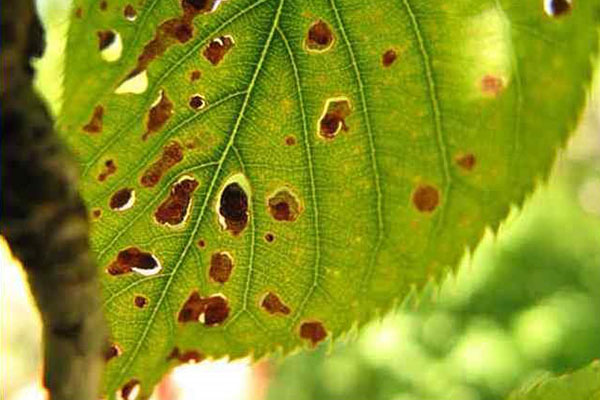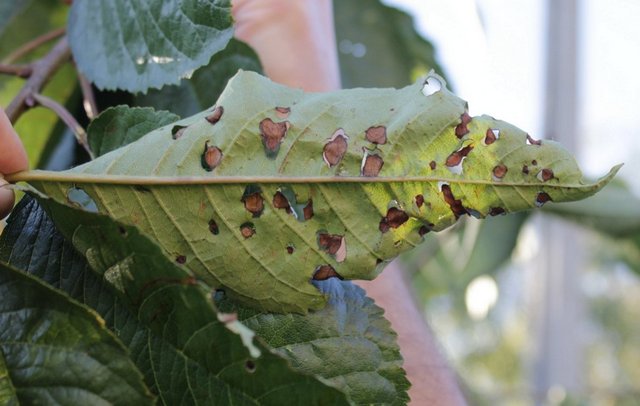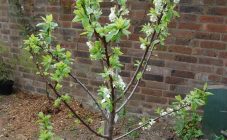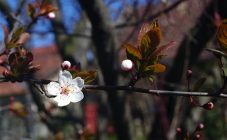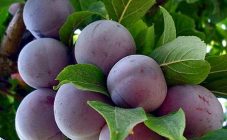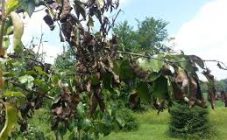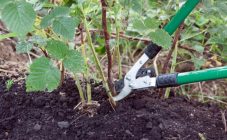Content:
In another way, this disease is called "perforated spot". The term clasterosporium is derived from the word "Clasterosporium" (clastero, sporium), which denotes the causative agent of the infection. Many inexperienced gardeners begin to panic at the sight of plum leaves in a hole, they do not know what to do while doing this. It is quite difficult to get rid of this disease, given that it is one of the most common. The main sign that the plum has undergone an ailment is the leaves covered with brown spots. At the location of the speck, the leaf dries out strongly, the tissue is destroyed, and a small hole is formed. As a result, the entire leaf blade becomes like perforated paper or a colander. The peak of the disease occurs in autumn, while the first signs appear in the spring. If clasterosporium is left untreated, the leaves will begin to crumble strongly, which, ultimately, will lead to loss of yield and death of the entire tree due to freezing. The onset and development of the disease is facilitated by the increased air humidity, which is characteristic of the damp climate of the Baltic States and northwestern regions of Russia.
Spread
Why does this disease occur? The causative agent of clasterosporium disease is the fungus Clasterosporium carpophilum, the source of which is plant residues containing fungal spores in their tissues. They are located next to other trees, so they can easily infect them.
The spread of infection occurs with the wind, as well as through rain and insects. The infected tree becomes a hotbed of further dispersion of conidia (immobile spores) over long distances, which are often measured in kilometers. If conidia gets on a leaf or a branch of a plum under high humidity conditions, infection occurs - the spore penetrates into the tissue of the tree. Clasterosporium disease attacks not only the leaves, but also all other aerial parts of the plant, including the buds, flowers and stems. On young green branches, the fungus forms overwintering mycelium, so they must be removed.
Disease development scheme
Stone fruit trees are susceptible to fungal infections throughout the growing season. The pathogenic process proceeds as follows:
- Small rounded dotted blotches with a pale yellow color appear on fresh leaves;
- Gradually the dots turn into brown holes;
- After 14-15 days, the spots dry out, collapse and fall off. As a result, numerous holes are formed, the leaves turn yellow and fall off.
Tree buds are also susceptible to fungal infections. When infected, they secrete a gum and do not open. Eventually they dry out, darken and do not fall off. Conidia accumulate in their scales, which form the wintering mycelium, and when the heat comes, they again begin to attack the aboveground organs of the trees.
At the first stage of fungal development, the affected stems turn red-violet. After 10-15 days, the spots turn yellow, practically fading, and a red border forms around them. The damaged areas of tissue dry out, cracks are formed, filled with a camell, as a result of which the stems die.
Signs of defeat
Common symptoms boil down to the following:
- the appearance of red spots on the leaves and other parts of the plant;
- holes appear on the plum leaves: the formation of holes occurs in those places where there were spots, and, as a result, the surface of the leaf is full of holes;
- red border around the leaf blade;
- gum removal of various parts of the tree;
- slight swelling of the kidneys, their dark color;
- early fall of flowers;
- the fruits are covered with ulcerative specks, as a result, the pulp rots, and the fruit dies.
Treatment
To protect the plum from adversity, they resort to such measures as fungicides, three of which are the most effective. Moreover, they do not pose a danger to human health. In addition, there is no harm from them to the plants themselves, while other agents can cause intoxication and tissue burns. In the fight against fungus, the following three drugs have proven themselves excellent:
- "Topaz";
- "Coming soon";
- Delana.
Trees are treated by spraying. Consumption of "Topaz" per tree is 15 liters. Apply the remedy during periods of opening of flowers and falling of petals. "Speed" will be effective when using 12-15 liters per tree during the fall of the petals and during the fall of the corollas. "Delana" is applied in the amount of 10 liters per one plum tree at the onset of the phenophase of corolla falling and the period of falling petals. The effectiveness of these drugs can reach 70% with a one-time treatment and 95% if treated twice.
Prevention of clotterosporia
Hole spotting in plums is preventable. This requires:
- cut, remove and burn diseased and dried plum branches (this should be done in the autumn season);
- timely remove and burn fallen leaves;
- regularly apply fertilizers rich in nutrients;
- process aisles, removing residues and rhizomes of weeds;
- process plums using special tools.
Traditional methods of treatment
According to experts, such methods are not very effective. Experienced gardeners use them as an additional way to get rid of the fungus.
Among the reliable prescriptions for this disease are the following:
- Slaked lime... The concentrated substance is mixed with water in a ratio of one to five. The resulting solution is applied to the tree trunk with a brush. The procedure is carried out several times every two weeks.
- Horse sorrel tincture. Apply it a few hours after preparation.
- Tincture of dry mustard leaves. After cooking, insist for two days. Strain before use.
- Removal of gum, treatment of crevices and cracks in stems three percent copper sulfate.
- Tobacco tincture, which will require 2-3 kg of tobacco and hot water. Raw materials are poured with water, kept out of the reach of light for two days.
Common mistakes novice gardeners make when treating plum clotterosporia:
- late start wellness activities;
- do not remove waste from the site after trimming damaged parts of the plum;
- do not remove the aboveground parts of the tree affected by the fungus and covered with gum.
The best way to get rid of
Thus, the answer to the question of how best to treat plum clotterosporiasis is as follows. The best option would be the complex use of fungicidal preparations and folk remedies for treating fungus (tinctures, manual removal of gum, etc.). It is also recommended to carry out preventive procedures (trimming the stems, feeding, processing with special sprayers, etc.).
Hole spotting is a common, rather complex and serious disease of stone fruit trees. However, with a competent approach to solving this problem, it will not be difficult to cure an infected plum.
